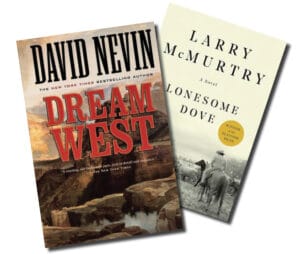Head of School’s Notebook — Perspective
October 11, 2019
I love Westerns. I always have. Lonesome Dove totally captivated me when I read it as a teenager. It was the only book—besides Where the Red Fern Grows—that had me in tears by the end. Something about the relationship between Gus and Woodrow struck a chord with me.
 So when Jay Dorion gave me a copy of Dream West in late August, I dove in. A bestseller when it was written in 1983 by David Nevin, the book tells the story of Charles Fremont and the mapping of the American West. It’s historical fiction, technically, but it’s a western through and through. And it’s long. So long that they made a mini-series out of it in 1986. I may have to watch that now, in fact.
So when Jay Dorion gave me a copy of Dream West in late August, I dove in. A bestseller when it was written in 1983 by David Nevin, the book tells the story of Charles Fremont and the mapping of the American West. It’s historical fiction, technically, but it’s a western through and through. And it’s long. So long that they made a mini-series out of it in 1986. I may have to watch that now, in fact.
What is remarkable about the book, and why I write about it today, is the rendering of the political landscape of the mid-nineteenth century. Charles Fremont, as it turns out, a soldier and explorer principally who gained great fame for his efforts to open the West to settlement, found himself the potential nominee for President in 1857 for two parties. The Democrats wanted him because he was born in the South and presumably sympathetic to the South’s interests. He was not.
But the nascent Republican party was happy to put up Fremont as their first candidate for President (Lincoln was their second), and Fremont agreed to stand for election. He lost in a relatively close race to James Buchanan, in large part because Fremont was not a politician, meaning that he was not willing to stoop to the unbridled vitriol that dominated the political landscape at that time. It’s instructive to read the account of misinformation, influence peddling, extortion and slander. Fremont even found himself the target of his father-in-law, Senator Thomas Hart Benton, who was an ardent Democrat.
Upsetting as it all is to read, it’s a fascinating look at the character of party politics and the trappings that remain with us very much today. Especially as we try to contextualize for our students the manner in which we might understand the throes of partisanship we are all encountering every day, a glance back in time is often the best path forward.
I was on an email string with members of the History Department recently who were trying to determine how best to contextualize the current challenges in Washington. Many were juxtaposing articles from various news sources—New York Times, The Economist, The Wall Street Journal, Politico, etc.—in an attempt to present information in a balanced, non-partisan manner. Strange that we could face such a challenge in this time of unending reporting. Nothing seemed quite right, though.
So instead the students in Advanced U.S. History, who had just begun a unit on the Constitution, complemented their work with a study of the Federalist Papers.
Other U.S. History classes were beginning their dive into the Revolutionary War, a time when newspapers, pamphlets, broadsides, and the like were growing in importance. One teacher used the study of that era and the dynamics both with respect to politics and the media to connect the past and the present, and to see the current conflict’s roots in the early throes of Democracy.
It was, candidly, invigorating to watch this pedagogy grow—evidence both of a remarkably thoughtful faculty and students eager to understand the present by learning about the past. Truth is an oft-debated and elusive concept in this day and age. Bias seems to undermine even the most fundamental tenets in our world. But history gives a way in to the discussion, a way to contextualize our behavior (past and present) and hopefully a way to find the meaning, the possibility, and the solid footing on which to stand and press forward.
Hard to imagine a better outcome from a history class.